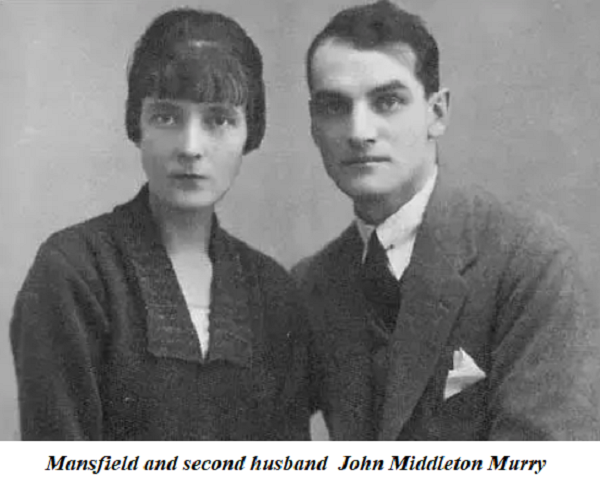
Never relight a dead cigarette or an old passion. —Katherine Mansfield
What Might Have Been How would the history of modern literature have evolved if Katherine Mansfield had not died a century ago at the age of thirty-four? Her influence on writers like D.H. Lawrence and Virginia Woolf is well known, as was the professional and personal challenge she presented to them as she explored her vision of literary Modernism. Born in New Zealand to parents of Australian ancestry, Katherine Mansfield was an innovative and influential short-story writer, poet, essayist, reviewer, journalist, and a leading member of the early Modernist movement. Like Woolf, and even pre-empting her, she believed she was breaking with the past and making a new beginning in literary history. And in pursuing this mission she hadn’t the slightest inclination to let her genius go unrecognised, even though she often felt an outsider in the London literary scene, upon which she erupted as a nineteen-year-old.
Mocked In London, Katherine found herself regarded as “the little Colonial walking in the London garden patch—allowed to look, perhaps, but not to linger”, as she later recorded in her journal in 1919. Her Kiwi accent was mocked—by Britain’s favourite war poet, Rupert Brooke, and others—while Woolf, with whom she enjoyed a love-hate relationship, shamefully described her as smelling like a “civet cat that had taken to street walking”; Dora Carrington dismissed Katherine as “very much a female of the underworld, with the language of a fishwife in Wapping”; while Lytton Strachey, not to be outdone, scolded her as “that foul-mouthed, virulent, brazen-faced broomstick of a creature”, scandalously ignoring the fact that he was referring to a young woman whose body was wracked by chronic arthritis and tuberculosis.
Prufrock Such cattiness was not unusual in the Bloomsbury circle. Katherine found herself invited to their soirees, having revealed herself to be an entertaining guest. A born story-teller, she was able to make rooms rock with laughter. “I don’t think anyone has ever made me laugh more than she did,” wrote Leonard Woolf in his autobiography. “There was not the shadow of a gleam of a smile on her mask-like face, the extraordinary funniness of the story was increased by the flashes of astringent wit.” Indeed, it was she who gave the first public reading of T.S. Eliot’s great poem “The Love Song of J. Alfred Prufrock” to a 1917 Easter gathering at Lady Ottoline Morrell’s country house, Garsington. Katherine believed that “Prufrock” was “by far and away the most interesting and the best modern poem”, and she was intrigued by Eliot (they were the same age, interlopers from former colonies, and at about the same point in their literary careers), and later wrote to Lady Ottoline how she’d met him at a party and walked home with him while “a great number of amorous black cats loped across the road”.
Scheherazade A few months later, Eliot published a prose dialogue, “Eeldrop and Appleplex”, the second half of which is concerned with sexual relationships and has a central character, Scheherazade, that is based on Katherine (Scheherazade’s gift for story-telling is celebrated in The Thousand and One Nights). Eliot has one of the other characters observe: “‘Not pleasure, but fulness of life … to burn with a hard gem-like flame,’ those were her words. What curiosity and passion for experience!” The words were in fact those of Walter Pater, at the end of his book The Renaissance, and had become the holy writ of the Aesthetic Movement, as Oscar Wilde proclaimed and as both Katherine and Eliot would have been very aware.
“Bliss” Some further light is thrown on Katherine’s relationship with the “Blooms Berries” (as she called them) by “Bliss”, one of her most famous stories. At one level it appears to be a straightforward account of Bertha, a society hostess, and her sudden enlightenment about her husband and a female friend with whom she felt a special bond. However, read between the lines it is also a sharply observed satirical portrait of a privileged elite, highlighting the fatuity of their professed aesthetic sensibilities as they swan about, secure in their crassly entitled blindness to the inequalities of the class system of which they are beneficiaries, while posturing as its critics. Bertha revelled in thoughts about her “modern, thrilling friends, writers and painters and poets or people keen on social questions—just the friends they wanted”, while one of them arrives, awfully upset by his incapacity even to cope with “a dreadful experience with a taxi-man; he was most sinister. I couldn’t get him to stop.” Famously, an outraged Virginia Woolf threw her copy of “Bliss” to the floor upon reading it.
The Sentinel There is another, much more profound dimension to “Bliss” that goes well beyond the surface satire and the melodrama of the tale. This is the “bliss, the absolute bliss” that suddenly possesses Bertha and entrances her throughout her seemingly magical day. This epiphany is centred on a pear tree in blossom in the garden that continually reappears in the story, and is there right at the end, as a devastated Bertha runs to the long windows: “‘Oh what is going to happen now?’ she cried. But the pear tree was as lovely as ever and as full of flower and as still.” In “Bliss”, Katherine gives Bertha a febrile vision that “resembles closely Mansfield’s own, her piquant and extraordinary appreciation of light, flowers, colours, sounds, scents and textures”. As Katherine herself said: “One cannot escape beauty, it is everywhere.”
“Wonderful—wonderful life” As she wrote to a friend as her TB really took hold:
As I write, the willows fly streaming in the sun—& someone is playing the piano—oh! So wonderfully—seeking out, gently, tenderly, with light, whimsical fingers something. Wonderful—wonderful life—I wish one could be certain of living to 100. Isn’t it awful to feel full of life and love and work and joy & to think one will have to turn up one’s toes & be still one day.
Elsewhere, in her journal she recalled “the amount of minute and delicate joy I get out of watching people and things”, and she celebrated the ineffable “detail of life, the life of life”. At the end of “Bliss”, with its jarring denouement, the pear tree stands as a sentinel guarding an elusive “something” that Katherine had Bertha recognise (but is kept from the reader) and that was ever-present in her own short life. (Claire Harman, All Sorts of Lives: Katherine Mansfield and the Art of Risking Everything, 2023)
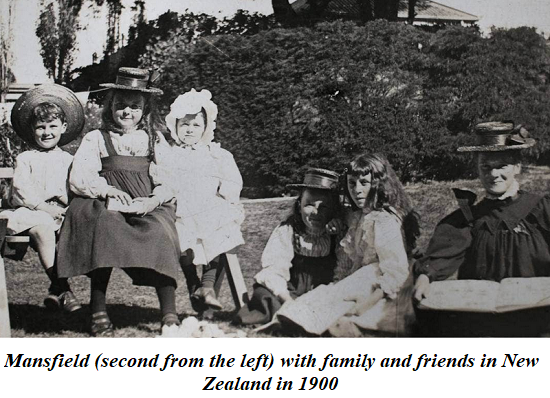 Childhood Born Kathleen Mansfield Beauchamp, Katherine Mansfield (as she renamed herself), was raised in affluent suburbs of Wellington in New Zealand. Her father was a successful businessman who was knighted and became chairman of the Bank of New Zealand, while her mother came from an upper-class family and was very conscious of the family’s status and of the social niceties. Katherine, her sisters and brother, went to New Zealand’s best schools, and the girls were also sent to Queen’s College in England for four formative years between 1903 and 1906, during which time they also travelled extensively around Europe.
Childhood Born Kathleen Mansfield Beauchamp, Katherine Mansfield (as she renamed herself), was raised in affluent suburbs of Wellington in New Zealand. Her father was a successful businessman who was knighted and became chairman of the Bank of New Zealand, while her mother came from an upper-class family and was very conscious of the family’s status and of the social niceties. Katherine, her sisters and brother, went to New Zealand’s best schools, and the girls were also sent to Queen’s College in England for four formative years between 1903 and 1906, during which time they also travelled extensively around Europe.
Besotted At Queen’s, a fifteen-year-old Katherine joined many other girls in becoming besotted with a young professor of German, Walter Rippmann: “I am ashamed at the way in which I long for German. I simply can’t help it. It is dreadful. And when I go into class I feel I must just stare at him the whole time. I never like anyone so much. Every day I like him more and more.” Rippmann became the mentor to these teenage acolytes, and he encouraged them to read the Continental Symbolists and the English Decadents, and other scandalous modern writers. These included Oscar Wilde, Henrik Ibsen, Arthur Symons (especially his very influential book The Symbolist Movement in Literature, 1899), George Bernard Shaw and Leo Tolstoy. This was heady stuff, and “Rippmann himself enjoyed some Wildean posing, and would advise the girls on the necessity of selfishness and avoidance of the Seven Deadly Virtues.” (Claire Tomalin, Katherine Mansfield: A Secret Life, 1988) Back in New Zealand, Katherine augmented this subversive canon by reading a range of books borrowed from the Parliament House library, including works by Edward Carpenter, Harley Granville-Barker, Honoré de Balzac, Gustave Flaubert, John Ruskin, Robert Browning, Walter Pater, Dante Gabriel Rossetti, the Brontë sisters, Nathaniel Hawthorne and Walt Whitman. All of this went towards the further cultivation of a rebellious, libertarian and aestheticist worldview, centred on the absolute conviction of the centrality of literature and the vital cultural mission of the writer.
Chekhov Amongst all these luminaries, Katherine’s acknowledged master was Anton Chekhov. She revered his work, and is credited with importing his “plotless” style of short story into English literature. In the lonely hotel rooms where she stayed as she pursued warm weather around the Continent during her last years, Katherine recorded how she’d lie awake at night and call on Chekhov, her teacher and fellow TB sufferer, dead himself in 1904 at the age of only forty-four. In her journal in 1918 she wrote: “Ach, Tchehov! Why are you dead? Why can’t I talk to you, in a big darkish room, at late evening—where the light is green from the waving trees outside. I’d like to write a series of Heavens: that would be one.”
Early Affections Katherine had embraced the joys and pitfalls of intimacy at an early age. An accomplished cellist, she fell in love in her mid-teens with the son of her cello teacher (and later in Britain she had an affair with his teenaged twin brother, with whom she became pregnant, after which he abandoned her). Then, at the elite Fitzherbert Terrace School in Wellington, she became intimate friends with Maata Mahupuku (1890–1952; also known as Martha Grace), the extremely wealthy granddaughter of a Maori chief and the daughter of a prosperous sheep farmer. Martha became Katherine’s muse for her early work and the two kept in contact throughout Katherine’s short life. Mansfield began a novel about Martha and herself, but only an outline and chapter survived. She also had an intimate relationship with Edith Kathleen Bendall, an artist nine years her senior whose studio was near her family home. (Later Katherine passed herself off as “Mrs K. Bendall”.) In Britain, Katherine and Ida Baker, a fellow student at Queen’s College, became lifelong friends. “LM” or “Lesley”, as Ida was rechristened, was devoted to Katherine and tirelessly supported her through her very difficult last few years.
“Going every sort of hog” Determined from childhood to be a major author, Katherine moved back permanently to Britain when she was only nineteen, a daring adventure for a single young woman, and one fortified by Oscar Wilde’s aphorisms “Push everything as far as it can go” and “The only way to get rid of temptation is to yield to it”, to which she added her own: “Never relight a dead cigarette or an old passion”. She led a reckless life in her teens and twenties, “going every sort of hog”, as Virginia Woolf noted disapprovingly, and her frantic quest for experience resulted in serial affairs, an unwanted pregnancy, an unconsummated one-day marriage, a miscarriage, rejection by her family, a sexually transmitted disease that crippled her health, and the tuberculosis that finally killed her. But through all this she worked tirelessly at honing her skills as a writer committed to extending the boundaries of what could be achieved in literature, producing many of her finest works in her stricken final years.
John Middleton Murry In Britain she met and eventually married her second husband, the ambitious  young writer and critic John Middleton Murry (1889–1957). Murry had started a new avant-garde literary magazine called Rhythm, to which Katherine had submitted a lightweight story that Murry rejected, requesting something darker. Katherine responded with “The Woman at the Store” (1912), a tale with an extremely effective horrific denouement. They soon became involved, although their backgrounds differed significantly. Murry was a year younger, a scholarship student at Oxford whose father was a minor clerk in the civil service and not the chairman of the Bank of New Zealand. He was also much less sexually experienced than Katherine, who had had many partners and had briefly been married. She seduced him by offering him lodgings at her flat, inviting him to make her his mistress, and then set about overcoming “terrors about sex created in his mind by an early encounter with a prostitute in Paris, an experience he had found loathsome”. (Elaine Feinstein, Lawrence’s Women, 1994)
young writer and critic John Middleton Murry (1889–1957). Murry had started a new avant-garde literary magazine called Rhythm, to which Katherine had submitted a lightweight story that Murry rejected, requesting something darker. Katherine responded with “The Woman at the Store” (1912), a tale with an extremely effective horrific denouement. They soon became involved, although their backgrounds differed significantly. Murry was a year younger, a scholarship student at Oxford whose father was a minor clerk in the civil service and not the chairman of the Bank of New Zealand. He was also much less sexually experienced than Katherine, who had had many partners and had briefly been married. She seduced him by offering him lodgings at her flat, inviting him to make her his mistress, and then set about overcoming “terrors about sex created in his mind by an early encounter with a prostitute in Paris, an experience he had found loathsome”. (Elaine Feinstein, Lawrence’s Women, 1994)
Stressful Experience She and Murry then edited Rhythm together, and many of her early stories appeared in it. Murry found living with Katherine a frequently stressful experience and they had extended periods apart, but he did go on to preserve her work and ensure her achievements were recognised. He himself was a prolific author and wrote early studies of Dostoevsky and D.H. Lawrence. It was through Murry that Katherine became friends with Lawrence, Virginia Woolf, Lady Ottoline Morrell, Bertrand Russell (with whom she may have had a brief affair) and others in the Bloomsbury circle, with many of whom she fell out, due to her ruthless intelligence, fearless, biting criticism, and mordant, deadpan humour.
The Lawrences Katherine and Murry became very close friends with Lawrence and his wife, Frieda. The Lawrences were reeling from government persecution and public disdain provoked by his pacifist views, and by the draining emotional aftermath of Frieda’s desertion of her husband and children to join Lawrence. The Lawrences often staged frightful rows and Frieda sometimes fled to Katherine for support before they invariably made up … until next time.
Sisters Frieda treated Katherine like a younger sister and regarded their relationship with the Murrys as the only really happy one they had, while Lawrence made the Murrys the basis for key characters in Women in Love. On the other hand, Lawrence’s opinionated intensity was infamous, as was his tendency to brutally judge and browbeat people. On one occasion he berated Murry in front of company for allowing Katherine to dominate him, which transgressed Lawrence’s sexual philosophy. Katherine was not overawed: “Whatever your disagreement is about, he says it is because you have gone wrong in your sex and belong to an obscene spirit,” she observed, and she suggested that Lawrence should call his cottage in Cornwall “The Phallus”. Nevertheless, she felt a common literary bond: as she wrote of his novel Aaron’s Rod: “I do not go all the way with Lawrence. His ideas of sex mean nothing to me. But I feel nearer Lawrence than anyone else.”
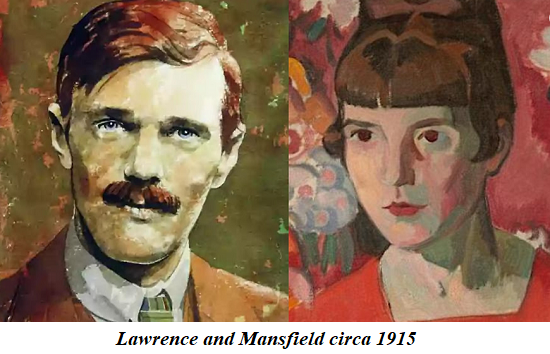 No Backward Step In mixing with this literary and artistic elite, Katherine never took a backward step, even though she was much younger than the “Blooms Berries” and enjoyed none of their financial or social security. Indeed, one biographer was shocked by Katherine’s “cannibal imagination” governed by “a furious impulse of aggression”, while another concluded: “Hers was a painful life”, one defined by an odd combination of “recklessness and scrupulousness”, and by a tendency towards deception and dissimilation. (Claire Tomalin, Katherine Mansfield: A Secret Life, 1987)
No Backward Step In mixing with this literary and artistic elite, Katherine never took a backward step, even though she was much younger than the “Blooms Berries” and enjoyed none of their financial or social security. Indeed, one biographer was shocked by Katherine’s “cannibal imagination” governed by “a furious impulse of aggression”, while another concluded: “Hers was a painful life”, one defined by an odd combination of “recklessness and scrupulousness”, and by a tendency towards deception and dissimilation. (Claire Tomalin, Katherine Mansfield: A Secret Life, 1987)
Masks Katherine’s capacity for dissimulation enabled her to persuade an older, good-natured singing teacher, George Bowden, to marry her, before deserting the relationship on their wedding night, having successfully become a married woman prior to the expected birth of another man’s child. (She had worn black with a black veil for the ceremony, and Bowden remained a bemused but supportive figure at critical times in her life.) Such behaviour can be understood in the context of her conception of the many “masks” she found herself wearing. This was noticed by those close to her; Dorothy Brett described Katherine’s pale face as “like a quiet mask, full of hidden laughter”. Lytton Strachey reported back to Virginia Woolf after his first meeting with Katherine, that she was “decidedly an interesting creature [with an] impassive mask of a face … and a sharp and slightly vulgarly-fanciful intellect sitting behind it.” (Hermione Lee, Virginia Woolf, 1997)
Double Game Katherine set out to charm Virginia as she considered publishing Katherine’s work. Writing to her of an important meeting, she described how she was “haunted’ by Virginia’s presence and her preparedness to support avant-garde work:
My God I love to think of you, Virginia, as my friend … Consider how rare is it to find someone with the same passion for writing that you have, who desires to be scrupulously truthful with you—and to give you the freedom of the city without any reserves at all.
Images Almost immediately, the two competing Modernist pioneers were “constructing images of each 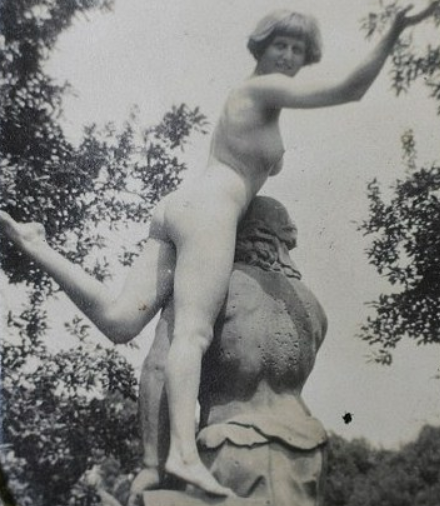 other”: “Katherine playing up Virginia’s fragility [and casting her as] one of those Dostoyevsky women whose ‘innocence’ has been hurt—Immediately I decided that I understood Virginia completely”; while Virginia emphasised Katherine’s “tough rakishness” and identified her with the “underworld … rootless, seedy metropolitan types … on the make professionally and sexually”, a view shared by Dora Carrington (right). But “Katherine was well aware that she was being sniffed at, and she too was playing a double game, praising [Virginia’s work] to Virginia’s face but calling it commonplace behind her back.”
other”: “Katherine playing up Virginia’s fragility [and casting her as] one of those Dostoyevsky women whose ‘innocence’ has been hurt—Immediately I decided that I understood Virginia completely”; while Virginia emphasised Katherine’s “tough rakishness” and identified her with the “underworld … rootless, seedy metropolitan types … on the make professionally and sexually”, a view shared by Dora Carrington (right). But “Katherine was well aware that she was being sniffed at, and she too was playing a double game, praising [Virginia’s work] to Virginia’s face but calling it commonplace behind her back.”
The Secret Disruption Indeed, as Ida Baker confirmed, Katherine was a “born actress and mimic”, and such duplicity came naturally to her, especially as she struggled to survive in the London literary world. Critics have recognised that the key to comprehending both her literary achievements and her life was this “dazzling talent for multiple impersonations”, and that her “narrative poetics are grounded in a precocious recognition of the self as many selves”. Indeed, Katherine’s career was built from the outset upon this “secret disruption”, “around a sense of the fragility, the mobility, and the multiplicity of personal identity. Highly conscious of personality as a mask, role, or performance, Mansfield inscribed this sense of the constructedness of the self, of personal identity, in her published and unpublished prose.” (Andrew Bennett, Katherine Mansfield, 2004) And, of course, the most obvious way in which she articulated a sense of fracturing and multiplicity in her personality was by naming and renaming herself, as she did several times in her life, including not only “Katherine”, but “KM”, “Katie”, “Kassie”, “Katerina”, “Katiushka”, “Tig”, and even “Elizabeth Stanley”.
“Secret sorrow” While this capacity to assume various personas allowed her to manipulate relationships and gave her a tremendous advantage in fashioning characters for her stories, it also confronted her with her own psychological challenge: how to unite them in one integrated self. In her late correspondence she wrote of her sense of having lived a double life, of being superficial, not only in relation to other people, but also in relation to herself. She explained, “I am always conscious of this secret disruption in me”, and she expressed her “secret sorrow” that she had always been, “in the deepest sense, disunited”. In her very last days she wrote to Ida, “I am a secretive creature to my last bones”, and it seems she remained that way to herself.
Her Work Katherine’s work (some seventy stories published in twenty-five languages) explored a range of subjects, generally at a quite intimate level. These included the preciousness, fragility and vulnerability of life and relationships; the complexities of family life; the allure and ambivalences of sexuality (a daring subject at the time); the effects of poverty and marginalisation; the personal and social consequences of the Great War (in which she lost her beloved younger brother); and the complexities, insecurities and (in)sensitivities of the intelligentsia. Working at the “micro” level, she explored the mind’s “inner state”, existentialist, mystical and ominous themes, and sought always to extract whatever meaning, beauty and vitality could be derived from even the most mundane and 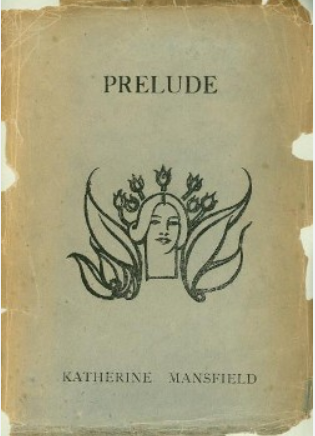 difficult experiences of life. She displayed a keen but often cutting sense of humour, and gradually developed a strong sense of identification with the New Zealand from which she’d so eagerly escaped as a teenager.
difficult experiences of life. She displayed a keen but often cutting sense of humour, and gradually developed a strong sense of identification with the New Zealand from which she’d so eagerly escaped as a teenager.
Prelude This found expression in Katherine’s novella, Prelude (1918), based on her own childhood experiences. It concerns a well-to-do family moving into a new house in the country and is written from the perspective of various characters without the provision of any explanatory or linking passages; the reader is simply plunged directly into one scene, and one character’s consciousness, after another. It had a critical impact on Virginia Woolf: “Its fragmenting of a whole family history into intense, solipsistic moments of experience, its funny child’s eye view, its brilliant tiny coloured details, its fluid movement between banal realities and inner fantasy, its satirical opposition of the female and male point of view, its sexual pain,” reinforced Virginia’s sense of where Modernist literature was heading and fortified her as she came to write her own masterpieces, Mrs Dalloway and To the Lighthouse. (Hermione Lee, Virginia Woolf, 1997)
“Psychology” Indeed, as a writer, Katherine can be well compared to Virginia Woolf, as they both realised. This is so particularly in Katherine’s disregard of narrative structure, and in the use of multiple perspectives, internal monologues, and streams of consciousness to develop her stories. Such techniques are vividly utilised in “Psychology” (1920) in which two unnamed writers enjoy tea at the woman’s flat while desperately manoeuvring to take their relationship to the next level: clearly they want to fall into each other’s arms but can’t take the final step. Consequently, the unifying factor in the tale is their fierce but rigorously unspoken desire to break out of the emotional cul-de-sac in which they find themselves. Katherine, as the author, manages the social choreography superbly, presenting, interchangeably, first the woman’s perspective and desires, then his, and then both at the same time, as they continually search for the breakthrough moment. The mutual frustration is both palpable and poignant, as are the reprimands they give themselves at their repeated failures to make that final connection. The overall effect is to depict their carefully mannered encounter as an event in one single libidinous mind, divided or alienated from itself.
The Psychological Novel And it wouldn’t be Katherine Mansfield if she didn’t introduce an ironic or parodic comment on the Modernist literary milieu in which she found herself. Seeking desperately for a conversational bridge from isolation to intimacy, the male character in “Psychology” ventures:
“I have been wondering very much lately whether the novel of the future will be a psychological novel or not. How sure are you that psychology qua psychology has got anything to do with literature at all?”
“Do you mean you feel there’s quite a chance that the mysterious non-existent creatures—the young writers of today—are trying simply to jump the psychoanalyst’s claim?”
“Yes, I do. And I think it’s because this generation is just wise enough to know that it is sick, and to realise that its only chance of recovery is by going into its symptoms—making an exhaustive study of them—tracking them down—trying to get at the root of the trouble.”
“But oh,” she wailed, “what a dreadfully dismal outlook.”
“Not at all,” said he. “Look here …”
And on the discussion went, until “it seemed they had really succeeded” in making the crucial connection between them: “Her smile said: ‘We have won.’ And he smiled back, confident: ‘Absolutely.’” But the overly triumphant smiles undid them, and they plunged back into a stifling self-consciousness: “‘What have we been talking about?’ thought he … ‘What a spectacle we have made of ourselves,’ thought she.” And “they were silent this time from sheer dismay”.
Tête-à-tête In this fashion, Katherine reduces recondite literary conversations like those enjoyed by the “Blooms Berries” to mere mating rituals, in this case one that fails under the weight of its own pseudo-profundity. It also can’t escape notice that one of the acknowledged pioneering masters of the psychological novel at the time was Fyodor Dostoevsky, about whom Murry had just published one of the first English-language studies, thus suggesting that the encounter described above had autobiographical origins in an early tête-à-tête between Katherine and Murry, as she persuaded him to take her on as his mistress.
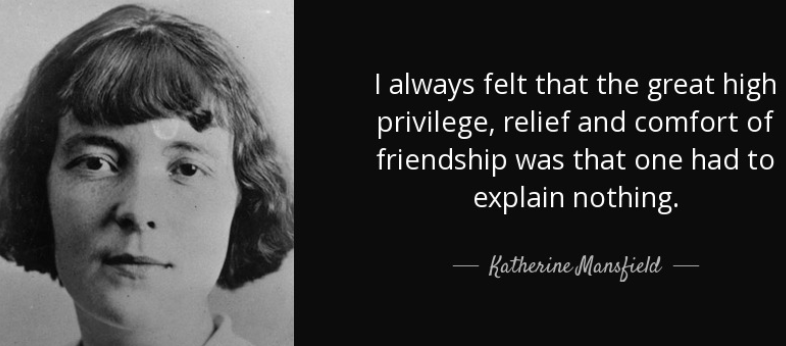
Consumption After Katherine was diagnosed in 1917 with pulmonary tuberculosis (which she probably caught from D.H. Lawrence) she worked desperately on her writing, hanging on to life and trying to record her vision as she wasted slowly away from sixty-six to thirty-eight kilograms. Finally, after years of chronic illness, physical pain, fruitless medical treatment and denial of the absolute seriousness of her condition, she gave up on medical treatment and took up residence at the “Institute for the Harmonious Development of Man” at Fontainebleau, a cult-like community run by the then very influential Theosophical guru, George Gurdjieff. It seems, in these last days, that she was trying to reach out from her own personal spiritual sense to connect with some more universal spiritual unity. At Fontainebleau she listened to talks, worked in the garden, and tried to compose herself for what was approaching. Eventually, in January 1923 the end came; she had run upstairs with excitement at a visit from Murry and collapsed with a dreadful haemorrhage. As he carried a blood-soaked Katherine to her room in his arms, she looked up into his eyes and sighed, “I think I’m going to die.” She was thirty-four.
Loss Katherine and Virginia Woolf had maintained a sometimes close, sometimes uneasy friendship as they competed for leadership of the Modernist revolution. “We have got the same job, Virginia,” Katherine wrote to the older woman, “& it is really very curious & thrilling that we should both, quite apart from each other, be after so very nearly the same thing. We are you know; there’s no denying it.” And Virginia conceded: “I was jealous of her writing, [hers was] the only writing I have ever been jealous of”. When Virginia heard of Katherine’s death, she wrote in her diary:
At that one feels—what? A shock of relief?—a rival the less! Then confusion at feeling so little—then, gradually, blankness & disappointment; then a depression I could not rouse myself from all that day. When I began to write, it seemed to me there was no point in writing. Katherine won’t read it.
And now never could.
Mervyn Bendle wrote on The Waste Land in the April issue
 Sign In
Sign In 0 Items (
0 Items ( Search
Search









Great.
What a tangled web the mind weaves – who is this estranged weaver, of such delicious de-light, and on the other hand, deadly irony. The irony of irony if one will’s it so.
?
Thank you for this most enjoyable read! A few years ago, we were in Hamilton, NZ. The good burghers had dedicated a section of their very delightful public garden to Katherine Mansfield, but were claiming on their (fortunately) draft plaque that she was about the equivalent of Shakespeare. I was able to persuade them that this was a touch ambitious and would likely draw the wrong kind of attention. A very polite subsequent email assured me that they had reconsidered their original accolade. One day, I may go back and check up…when NZ has recovered from the tender mercies of Ardern.
Perhap-mayhap…